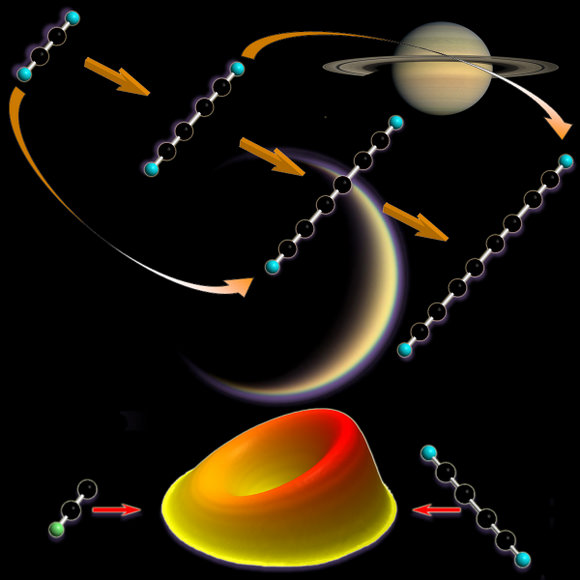[/caption]
Titan appears to be more like Earth all the time, and a new understanding of Titan’s hazy atmosphere could provide clues to the evolution of Earth’s early atmospheric environment and the development of life on our home planet. Researchers have discovered a series of chemical reactions on Saturn’s largest moon that may shield the moon’s surface from ultraviolet radiation, similar to how Earth’s ozone layer works. The reactions may also be responsible for forming the large organic molecules that compose the moon’s thick and hazy orange atmosphere.
Scientists have long understood that high in Titan’s atmosphere, sunlight breaks apart methane into carbon and hydrogen. These elements react with nitrogen and other ingredients to form a thick haze of complex hydrocarbons which completely enshrouds the moon.
But recently, the role of polyynes in the chemical evolution of Titan’s atmosphere has been vigorously researched and debated. Polyynes are a group of organic compounds with alternating single and triple bonds, such as diacetylene (HCCCCH) and triacetylene (HCCCCCCH). These polyynes are thought to serve as an UV radiation shield in planetary environments, and could act as prebiotic ozone. This would be important for any life attempting to form on Titan.
“Even if you form biologically important molecules (via other reactions) and there is no ozone or ozone like-layer, these molecules will not always survive the harsh radiation environment,” said Ralf Kaiser, lead scientist of the study.
However, the underlying chemical processes that initiate the formation and control the growth of polyynes have not been understood.
Kaiser and his colleagues studied the formation of triacetylene and larger organic molecules in the lab and in computer simulations. They found that triacetylene can be formed by collisions between two small molecules in a reaction that can be easily initiated under the cold conditions found in Titan’s atmosphere.
The authors suggest that triacetylene, an organic molecule that could act as a shield for ultraviolet radiation, may serve as the building block for creating complex molecules in Titan’s atmosphere.
“The present experiments are conducted with molecules containing carbon and hydrogen atoms only,” Kaiser told Universe Today. “To investigate the formation of astrobiologically important molecules on Titan, we have to ‘add’ oxygen and nitrogen, too.” Kaiser said they plan to do those type of experiments later this year.
The team said they hope their combined experimental,theoretical, and modeling study will act as a template, and trigger much needed, successive investigation of the chemistry of surrounding Titan so that a more complete picture of the processes involved in the chemical processing of moon’s atmosphere will emerge.
Lead image caption: Crucial building blocks in the organic haze layers of Titan and possibly of early Earth come from chemical reactions. Image credits courtesy of NASA-JPL, Dr. Xibin Gu, and Reaction Dynamics Group, University of Hawaii
Source: PNAS


Very interesting article
Cryogenic biology anyone?
Tell me again why we aren’t targeting Titan (and Enceladus) for the next large mission? These investigations don’t need “search for the water” any more, they need “search for the organics”.
Btw, while we are on the subject of potential biology, Corot/HARPS seems to have announced another of two super-Earths around the same main-sequence star contending for the smallest at 4.8 +/- 0.8 Earth mass. (Seems it is transiting, which I presume makes it an estimate of mass and not minimum mass.) They even give a likeliest density close to Earth.
It’s a weak signal though, and it must be awfully hot with that small orbit period. What is more interesting IMHO is that just as the current generation of exoplanet instrument gives up they are starting to see a lot other stuff than those “boring” super-Jups.
Duh! “exoplanet instrument gives up” – exoplanet instruments give up.
Speak of transposing. Need more coffeeehhhh… [/coffee zombie state]